Negative keywords are essential for optimizing Google Ads campaigns. They’re the mechanism that stops your ads from appearing in irrelevant searches on Google, saving your budget from unqualifed clicks and improving your targeting.
This article covers exactly what negative keywords are, the different types you can use, how to identify them, and how to incorporate them into your campaigns.
Let’s jump in.
What Are Negative Keywords?
Negative keywords are critical yet often overlooked elements of Google Ads campaigns. These specific terms help avoid showing your advertisements during searches that don’t align with the intended audience, thus ensuring only potential customers interested in what you offer see your ads.
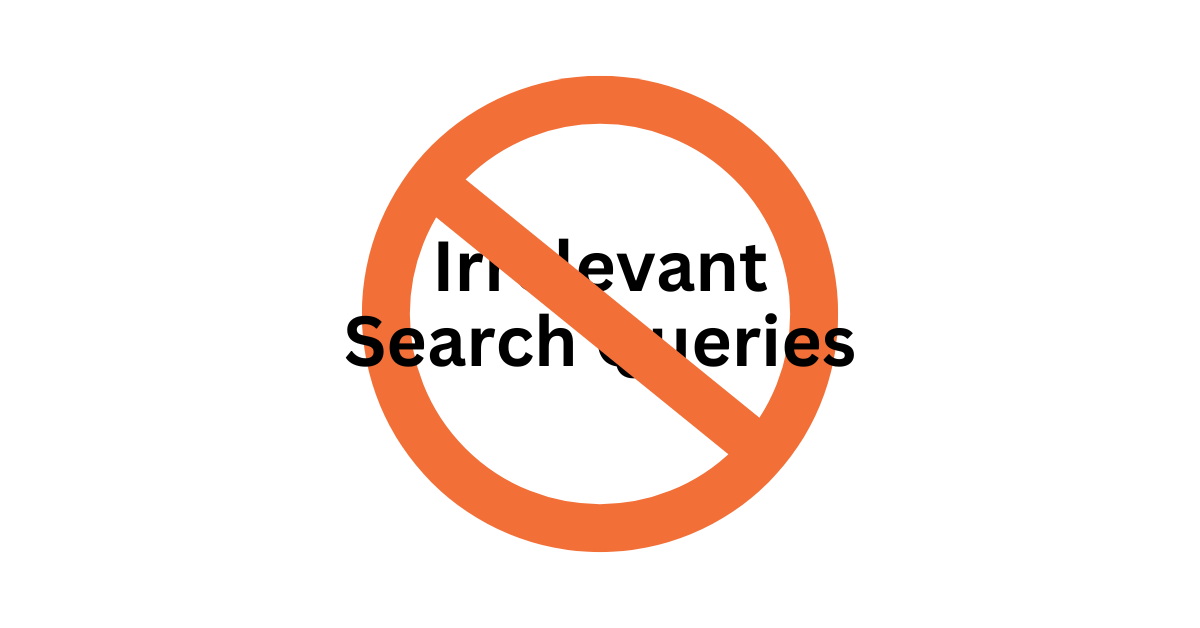
For instance, if you’re promoting high-end watches and individuals seeking inexpensive options trigger your ads, it can lead to frustration and unnecessary spending. Negative keywords step in to prevent such mismatches by filtering out these non-relevant queries, thereby maintaining a focused and efficient use of your ad budget.
Using negative keywords substantially enhances how targeted each ad is. It eliminates irrelevant search traffic from seeing the ad, which not only bolsters its relevance but also cuts down on extraneous expenses associated with uninterested parties clicking through—positively influencing both Click Through Rate (CTR) and Return On Ad Spend (ROAS).
This filter leads to cleaner, more precise campaign targeting that harnesses more suitable audience segments while improving overall return on investment (ROI).
Here’s a quick view of how they would look in an ad account:
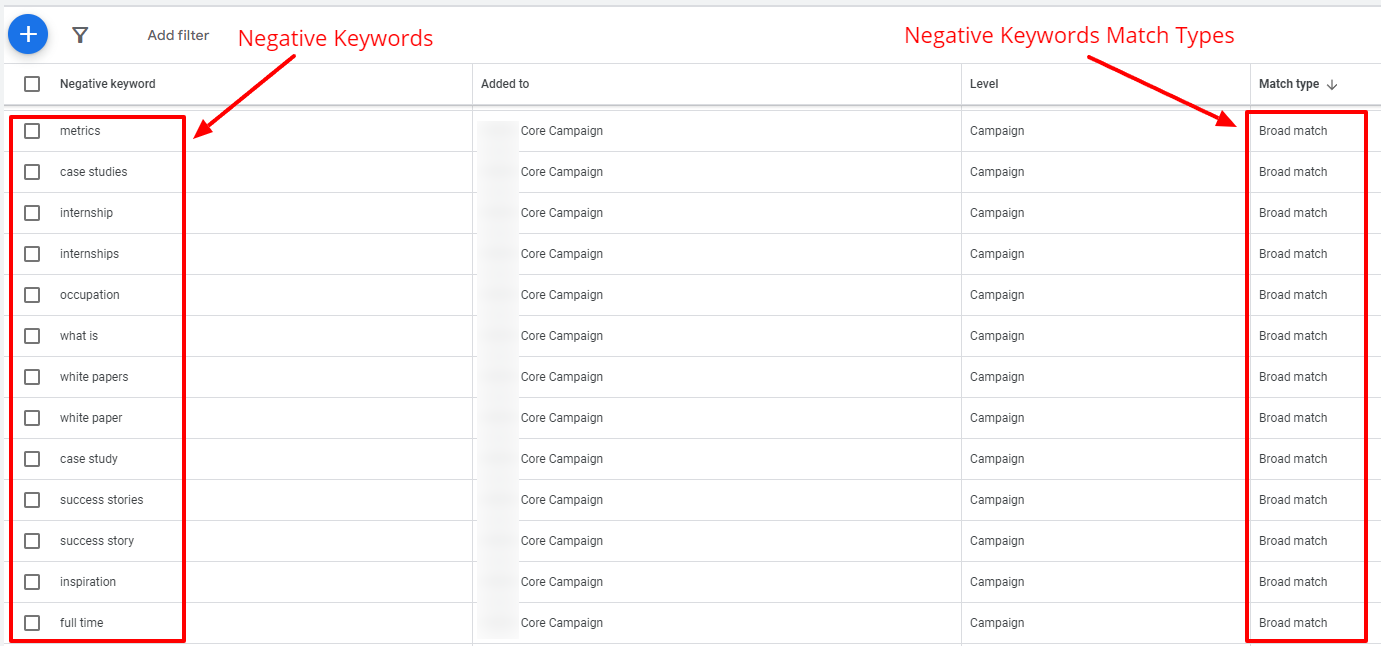
Integrating negative keywords isn’t only about avoiding unsuitable search phrases. It’s crucial for honing who sees your online advertisements so that they pinpoint precisely those audiences most relevant to what’s being offered. And they can be applied at the account level, campaign level, and even ad group level.
In doing so, you’ll sharpen your campaign’s relevancy and cut down on wasted spending—a move that directly controls the effectiveness of your advertising efforts.
Key Takeaway:
Types of Negative Keywords
Alright, we’ve covered the basics of negative keywords. Now let’s look a little closer at the different types currently available.
There are three main types of negative keywords: negative broad match, negative phrase match, and negative exact match.
Knowing the differences between them is key to fine-tuning your ad campaigns. Figuring out which type to use in specific situations helps you easily decide which search queries will trigger your ads and which won’t.
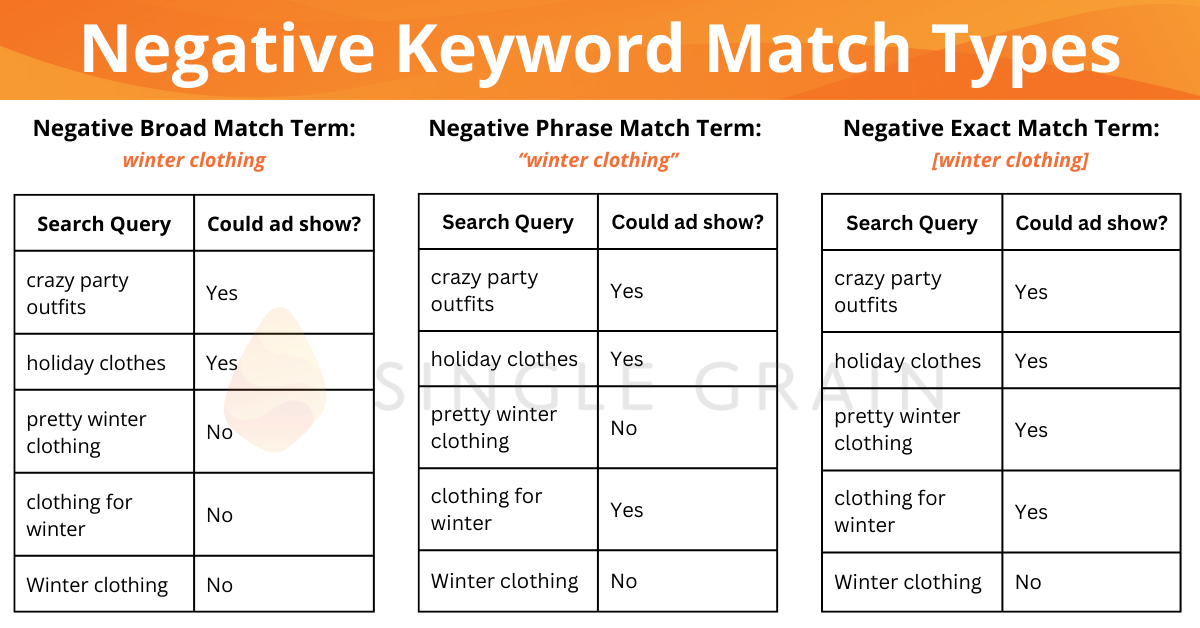
- Negative Broad Match: This type stops your ads from showing up when every term from your keyword appears in a user’s search query, no matter the order. For example, if you set “free trial software” as a negative broad match keyword, then any search containing “free,” “trial,” and “software” — in any order — won’t trigger your ad. It’s a great way to filter out a bunch of irrelevant searches.
- Negative Phrase Match: Your ads won’t show up when the search includes your exact keyword phrase, plus any extra words at the start or end. So, if “cheap hotels” is your negative phrase match keyword, searches like “cheap hotels in New York” won’t trigger your ad. But something like “affordable hotels” might still show your ad.
- Negative Exact Match: This is the most precise option. Your ads won’t show up for searches that exactly match your keyword phrase, without any extra words. It’s super useful for cutting out very specific searches that aren’t relevant to what you’re offering.
Getting a handle on how each of these types each work is crucial for making your ad campaigns as effective as possible.
Key Takeaway:
How to Identify Negative Keywords
Optimizing your Google Ads campaigns includes the crucial process of finding negative keywords. This helps you filter out search queries that don’t match your target audience, letting you use your ad budget more efficiently.
Here are are the best ways to spot negative keywords:
1) Use Your Intuition
Trusting your intuition can be a surprisingly effective method for identifying negative keywords. Often, you have a good sense of what terms might attract the wrong audience or don’t align with your campaign goals.
For example, if you’re advertising luxury watches, terms like “cheap” or “discount” might not align with your brand’s image and could attract users looking for budget options, which aren’t your target audience.

Adding these intuitive negative keywords to your list can save your budget from unqualified clicks and improve your ad relevance. It’s a simple yet powerful way to ensure that your ads are seen by the most suitable audience.
While it might seem less scientific, your gut feelings are often based on your experience and understanding of your market, making them a valuable tool in your keyword strategy.
A good way to get started with this is to brainstorm all of the things your brand and offer is not. From there, you can start to built out a list of terms and phrases you wouldn’t want an ad of your to appear for if someone searched for it.
2) Use Keyword Research Tools
In the early phases of conducting keyword research for paid search campaigns, it is essential to pinpoint negative keywords.
This helps eliminate terms that do not align with your campaign’s goals right off the bat, sharpening your focus on the intended target audience and increasing the likelihood that suitable individuals see your advertisements.
A keyword research tool, like Google’s Keyword Planner, can help in uncovering specific search queries that might be inappropriate or unrelated to what you aim to promote. This is, of course, a more preliminary, manual approach, but can be very helpful in revealing audience trends surrounding terms that aren’t quite on the mark with your offer.
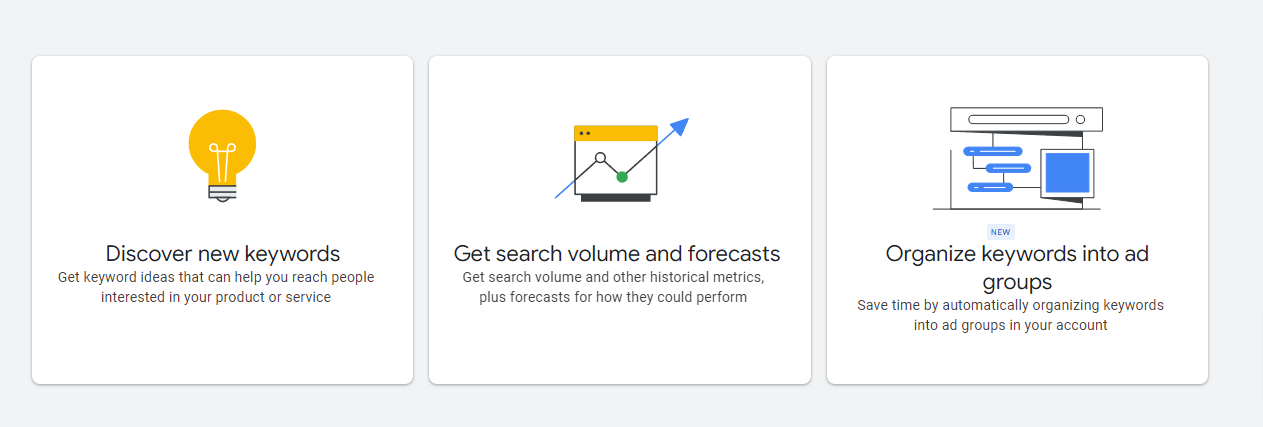
Let’s go back to the watch example real fast and assume you’re selling your own brand of smartwatches. For the sake of example, we’ll say the watches you’re selling aren’t Apple or Samsung watches.
You’re curious to see the behavior behind the keyword “watches.” Let’s see what turns up in Keyword Planner:
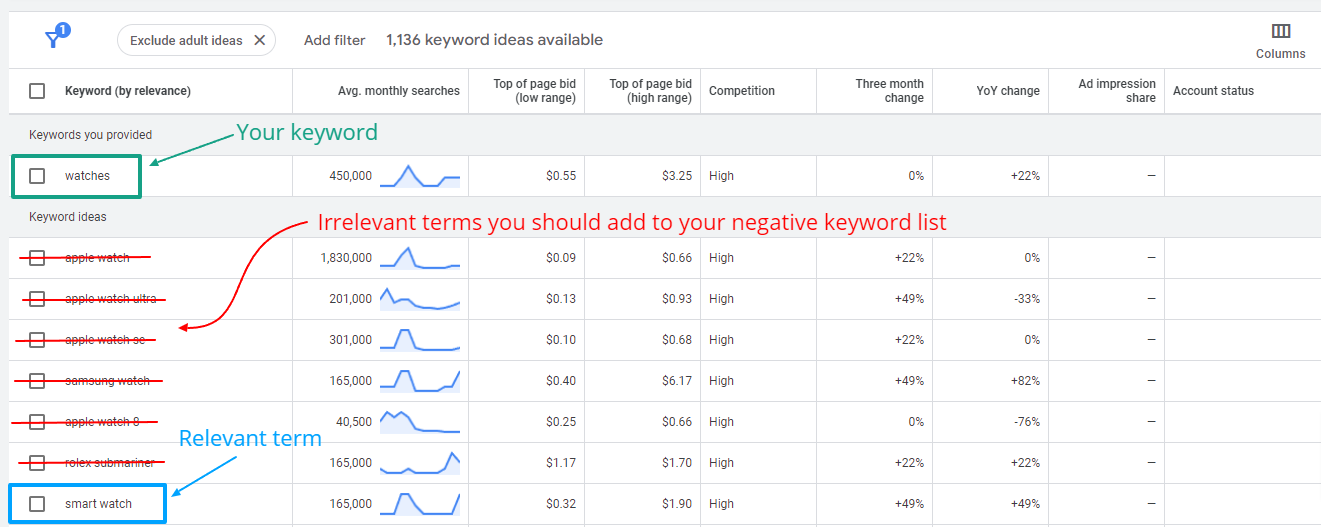
Ruling out these irrelevant queries for terms like “apple watch,” “samsung watch” and others of that ilk will allow you to refine your paid search efforts and boost their overall effectiveness (avoiding wasted spend on product searches not relevant to you).
3) Use Google Ads’ Search Terms Report
Using the search terms report in Google Ads is super helpful for finding negative keywords. This report shows you the exact search queries that triggered your ads, helping you spot any irrelevant keywords that might be wasting your budget. Regularly analyzing this report can improve your targeting and save you money.
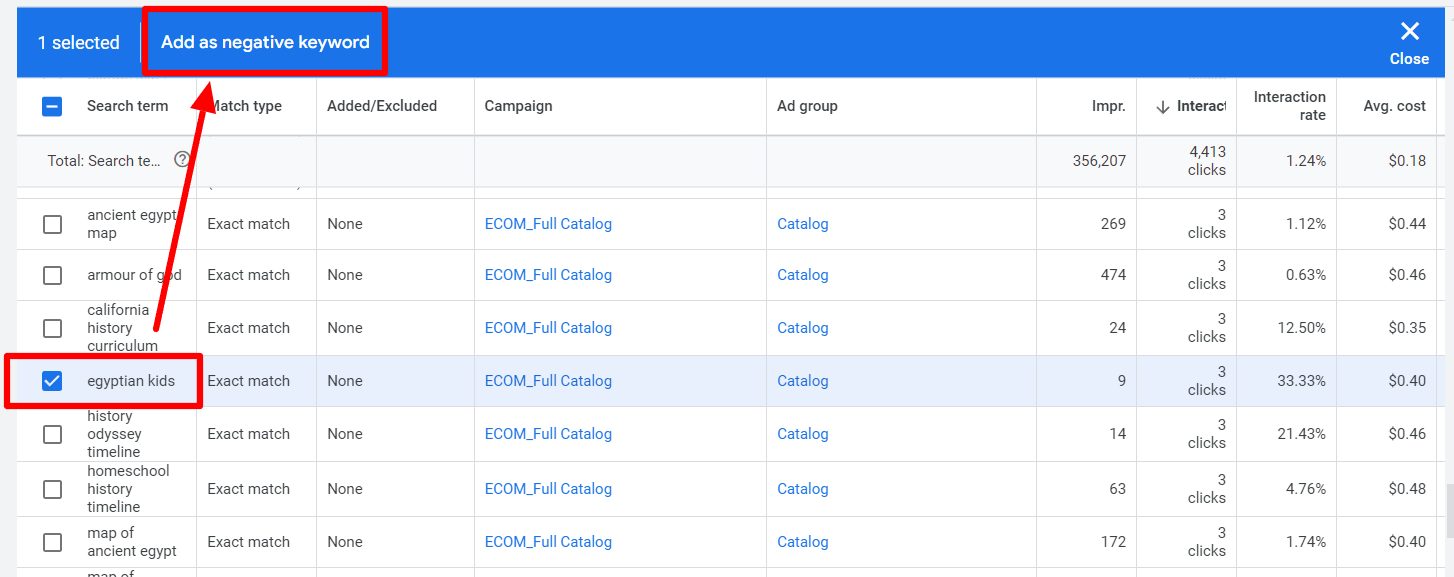
However, it’s important to note that advertisers are only able to view ~50-70% of the search terms that trigger ads. This limitation means that some irrelevant searches may still slip through unnoticed, potentially affecting your ad performance.
Moreover, Google has started providing search categories for most campaigns instead of detailed search terms. This change can make it more challenging to pinpoint specific irrelevant queries, as the broader categories might include a range of search terms—some of which may not be relevant to your campaign. As a result, you might be matching to more irrelevant searches without even realizing it.
Using filters within the Search Terms interface makes it easier to find negative keywords quickly. Keeping an eye on these reports is key to maintaining the relevance of your ad campaigns and making sure you’re spending your advertising budget wisely.
4) Use Scripts to See Performance Max Search Terms Reports
While Google Ads doesn’t directly provide search term data for Performance Max campaigns, you can use a script to extract this information. These scripts interact with the Google Ads API to retrieve the search terms that triggered your ads. This can be especially useful for understanding the effectiveness of your campaigns and identifying negative keywords.
Here’s a brief overview of how to use scripts:
- Access the Google Ads Script Editor: Log into your Google Ads account and navigate to the Tools & Settings menu. From there, select “Scripts”
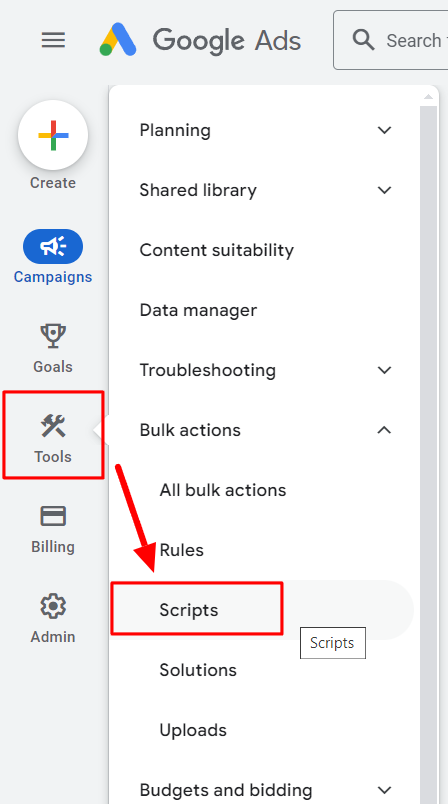
- Create a New Script: Click on “+” > “New” to create a new script.
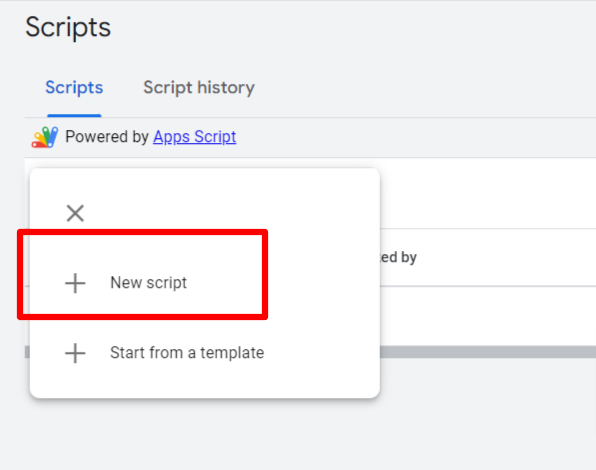
- Paste the Script Code: Copy and paste the relevant script code into the editor. You can find many publicly available scripts online that are designed to extract search term data from Performance Max campaigns.
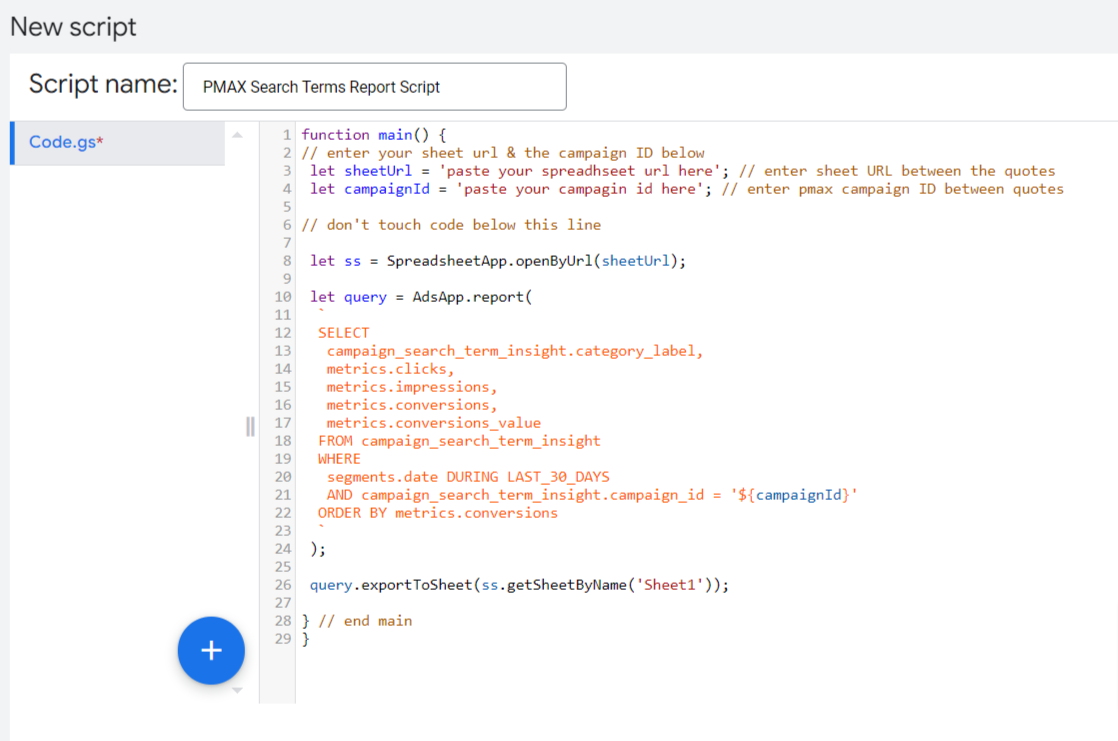
- Run the Script: Once you’ve pasted the code, click on “Run” to execute the script. The script will typically output the search term data in a spreadsheet or other format.
If you’d rather have someone do it for you, the paid media team at Single Grain are experts in handling custom scripts in Google ad campaigns. We’d love to help you out.
Note: While scripts can provide valuable insights, they may have limitations due to Google’s restrictions on accessing search term data. The amount of data you can retrieve may vary, and there’s a possibility that some search terms might not be accessible.
Developing Your Negative Keyword Strategy
Creating a solid negative keyword strategy is key to making your Google Ads campaigns work better.
A quick word of warning: be careful not to overdo it. Too many negative keywords can limit your ad’s reach. You want to trike the balance of controlling irrelevant search terms while also allowing enough space to attract a variety of relevant queries.
Let’s go through the two main actions you should consider when approaching your Negative Keywords.
1) Group Negative Keywords
Categorizing negative keywords into themes or categories fine-tunes Google Ad campaign management and increases the accuracy of targeting. Structuring these keywords according to product type or the intent of the customer sharpens their applicability, leading to more refined ad group oversight.
Employing this strategy permits better judgment on keyword exclusion choices, guaranteeing that your advertisements reach an audience with higher relevance. The skillful assembly of negative keywords is instrumental in achieving more precisely focused and streamlined ad campaigns.
2) Regularly Review and Update Lists
Consistently monitor and refresh your negative keyword lists, adapting them in response to fluctuating market conditions and variations in search patterns. Keeping pace with the dynamic nature of search trends maintains the relevance as well as effectiveness of your advertisements.
Regularly overhauling your negative keyword lists ensures that your ads are seen by a targeted audience while also fine-tuning your campaigns for improved outcomes. Such diligence is key in responding to ongoing changes within the marketplace and sustaining successful advertising strategies.
A Note on Broad Keywords and Smart Bidding
Broad keywords and smart bidding are the only way to really tap into Google’s AI bidding. But here’s the catch: without having negatives in place, you’re giving Google way too much control over your account. Remember that DOJ investigation where Google admitted to bumping up the floor price of bids by 10%? It’s yet another signal that Google doesn’t exactly have your best interests at heart.

Source: WordStream
Understanding the importance of each negative keyword match type is key to fine-tuning your ad performance. Using negative broad match keywords is a basic yet crucial strategy for refining your ad campaigns.
Stopping your ads from showing up in any search query that includes all the terms of your negative keyword, no matter the order, filters out a lot of irrelevant searches. This broad exclusion helps save your ad budget and boosts the overall targeting precision of your campaigns.
Last Thoughts on Negative Keywords
Negative keywords are one the key components of optimizing any Google Ads campaigns. And with how much more Google is loosening the bounds by which it pairs advertisers’ keywords with user queries, negative keywords are your best bet at maintaining any semblance of control. Invest the time early in cultivating your negative keyword list. But don’t stop at that either. Your negative keywords list should be a living, breathing thing that you constantly revisit and modify.
If you keep a watchful eye on your search terms report, and frequently update your negative keywords, you’ll have much healthier ad account in the long-run.
If you’re ready to start optimizing your negative keywords, Single Grain’s paid media experts can help!👇
Recommended Video
For more insights and lessons about marketing, check out our Marketing School podcast on YouTube.
Frequently Asked Questions
-
What are negative keywords, and why are they important for Google Ads?
Negative keywords are specific terms that prevent your ads from showing up in irrelevant search results. By adding negative keywords to your campaign, you can stop your ads from appearing for search queries that don’t match your business, saving your budget and improving the relevancy of your ads.
-
How do negative keywords improve my ad performance?
Negative keywords help filter out irrelevant search traffic, reducing wasted clicks and improving the precision of your ad targeting. This leads to a higher Click Through Rate (CTR) and Return On Ad Spend (ROAS), as your ads are shown to a more relevant audience.
-
What are the different types of negative keywords, and when should I use each?
The three types of negative keywords are:
- Negative Broad Match: Excludes search queries containing your keyword terms in any order. Use this for broad filtering.
- Negative Phrase Match: Excludes searches containing your exact keyword phrase plus additional words before or after. Ideal for specific filtering.
- Negative Exact Match: Excludes searches that match your exact keyword phrase without additional words. Best for precise targeting.
-
How can I identify negative keywords for my campaigns?
You can identify negative keywords by using keyword research tools like Google Keyword Planner, reviewing your Google Ads search terms report, and performing manual searches to find irrelevant phrases. This process ensures you’re adding the right negative keywords to improve targeting.
-
What’s the best way to add negative keywords to my Google Ads account?
You can add negative keywords either at the ad group level or the campaign level. The easiest way is through the search terms report or directly via the Google Ads dashboard. This allows you to create a new negative keyword list or update an existing negative keyword list as needed.
-
Should I add negative keywords to both the campaign and ad group levels?
Yes, adding negative keywords at both the campaign and ad group levels can provide more granular control over where your ads appear. Use campaign-level negative keywords for broader exclusions and ad group-level negative keywords for more specific filtering.
-
How often should I update my negative keyword list?
Regularly reviewing and updating your negative keyword list is crucial. As search trends change, new irrelevant keywords may appear. Checking your search terms report frequently will help you find negative keywords that can be added to maintain the relevance and efficiency of your campaigns.
-
Can too many negative keywords hurt my campaign performance?
Yes, using too many negative keywords can limit your ad reach, reducing visibility and potential conversions. It’s essential to find a balance by adding only those negative keywords that help you avoid irrelevant searches without cutting off valuable traffic.



